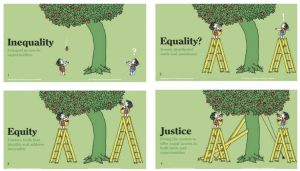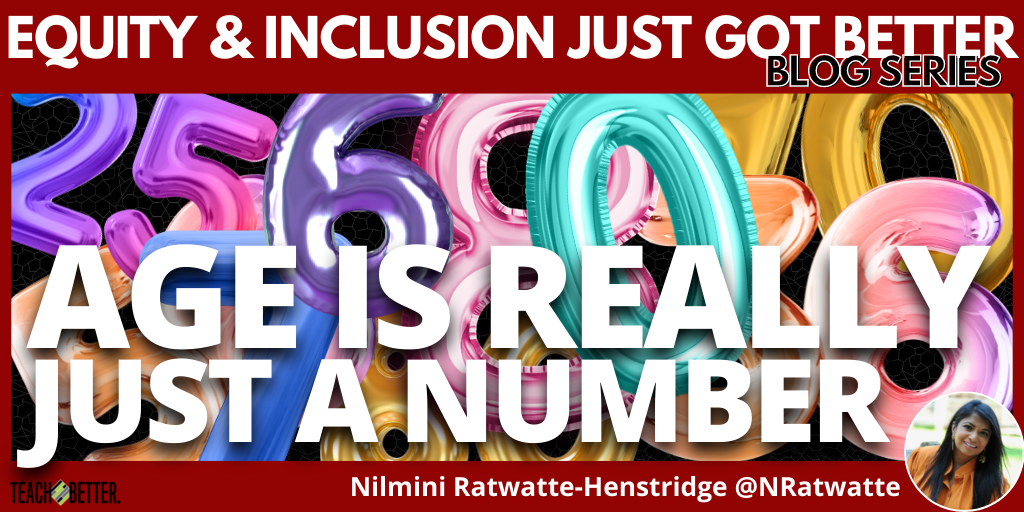TL;DR:
- Ageism is a valuable topic to reflect on and discuss.
- There are collaborative strategies you can use to increase student engagement in discussions.
As the year goes by, we think of our age as an accomplishment, a number that made meaningful moments matter and time really does fly by. What is important to consider is how age contributes to making life incredible in the way we want to live it!

https://www.researchgate.net/figure/Equality-Equity-and-Justice-Source-Tony-Ruth-from-Maeda-2019_fig2_354087577
It’s a quiet day at home as I type and think about the topic of ageism in schools, classrooms, and in society.
Age—is it just a number?
I think it’s wisdom and knowing yourself as a person well enough to be able to speak the truth, stand up for what you believe in, and know your limitations and abilities. I loved every year that I lived. And aging gracefully is something I look forward to as the years go by.
I loved every year that I lived. And aging gracefully is something I look forward to as the years go by. Click To TweetBelow is a lesson from my classroom you can try out with some guiding questions for you to reflect on this year.
Equity and Inclusion Reflection Questions:
- Why does the society we live in consider “age” so important in so many ways?
- Think of a time when you have had to stop, reflect, and change to accommodate your way of doing something because you were working with someone else who was unable to do things the way you can because of your age.
- How would you make it possible for someone else to be as successful who is considered as having less experience or being highly qualified due to their age?
Reflect on Ageism
I’m a Virgo, and for all the Virgos who recently celebrated their birthdays just like me…we are older by a year and wiser with age.
Ageism is when people get discriminated against because of their age. Usually, this is prevalent as we age. We can see it in all industries—the bias associated with aging is widespread with assumptions of costing the invaluable advice, experience, and guidance that we bring with us as we age.

The Giving Tree (click here to listen in Sinhala)
You can use all text in translation when teaching to discuss concepts of aging and how age can contribute towards societal values. Currently, Sinhala is an Indoor-Aryan language that was brought to Sri Lanka in the early 6th century BCE and is spoken by approximately 20 million people in the world. This is the language I studied since when I grew up in Sri Lanka. There was a separation between Tamil and Sinhala as languages. Acknowledging that all languages in the world are important and to be respected and recognized since they’re a part of our diverse world heritage.
Media art lesson that can bring about discussions
This birthdays media clip can start off a lesson where we collaborate with students and get to acknowledge that we can learn from each other.
I love to start a courageous conversation about AGE, experience, and perspectives. I love to use this as a lesson entry point to show that every age can teach us life lessons as we experience life and the paths it takes. The way you use the lesson can depend on your comfort level.
Below are three ways you can teach the concept of ageism using some strategies from my classroom.
What? You are really reading this blog about teaching strategies, which is kind of cool! I wish I had this when I was a new teacher so that I could learn at my own pace in the field and try things out. If these strategies work, feel free to tag me on social media from your classrooms. I introduce these three strategies to you in order of how I think you should try them. This is strategic to ensure that you are successful with them while trying them in your classroom. I can honestly tell you, l love them. They are my favourite go-to strategies in a classroom! Student engagement levels will be high. You will be a fly on the wall of your own classroom; ensure that you can listen and make anecdotal notes while participating and engaging with learners.
[scroll down to keep reading]Think Pair Share
Set Up: Ask students to find a partner and sit or stand facing each other to share when you give a topic to talk about.
I love think-pair-shares. They give students an opportunity to share their thinking, make friends, and hear other students’ thoughts in class on a given topic.
Inside-Outside Circles
Set Up: Make two circles with your students. Ask the inside circle to face the outside circle. When you give a question, the students facing each other talk. When you say “switch,” the outside circle moves in the same direction to rotate partners. The inside circle stays the same.
I use this all the time in my classroom. This strategy is great for auditory-kinaesthetic learning extensions to hear perspectives and opinions, and have opportunities to collaborate with the whole class at the same time.
Four Square Switcharoo!
Set Up: This works best in groups of 4 ideally since each person is going to have a four-square template graphic organizer. The paper has each student’s name on one of the squares. When given a question, each student responds on paper. Then each student will be able to switch the papers in a clockwise direction. At the end of the task individually each student has their partner’s answers on paper.
I love these teaching ideas since they have been successful in my classroom. Students in my classroom learn collaborative skills and group work skills one step at a time. Eventually, they grow in group size from partners and groups of four to whole class collaboration. Remember group work is a specific set of skills, and it takes time. One key takeaway from my experience is that you really do have to give students choice in the partners that they pick while alternating by choosing strategic partners for tasks.
Yours in Education,
Nilmini
About Nilmini Ratwatte-Henstridge
Nilmini Ratwatte-Henstridge teaches in Brampton, Ontario, Canada. She was born in Sri Lanka and immigrated to Canada with her family. As an elementary school teacher who is passionate about equity, social justice, and human rights in education, she enjoys teaching the younger generation to be global-minded citizens.
Discovering the world by connecting with others is an opportunity that we have today in our society today and she loves meeting new people! She is always learning while traveling to understand the inter-connectedness of this beautiful earth we live in! Nilmini LOVES cooking great meals, watching movies, and the latest fashion trends! Family and friends are close to her heart as she looks forward to balancing social media and navigating professional learning communities in education to network globally this year!





